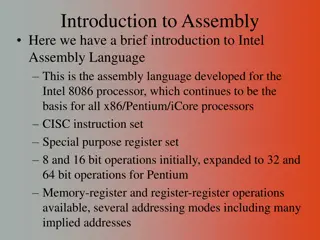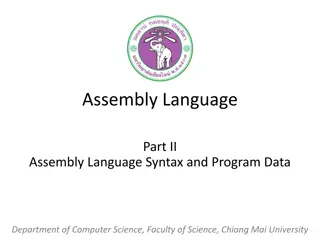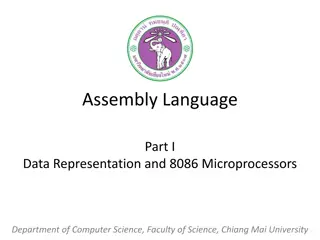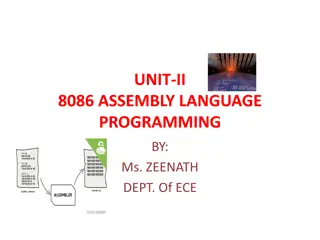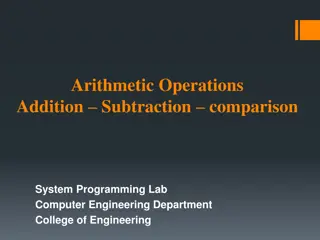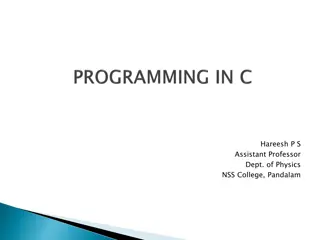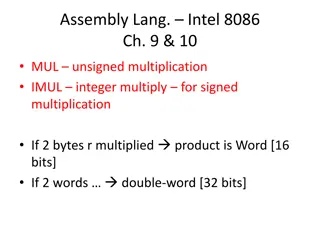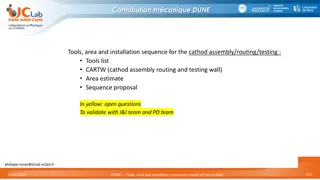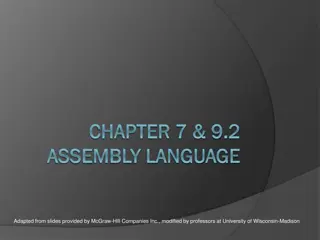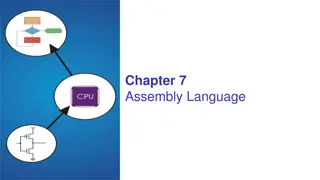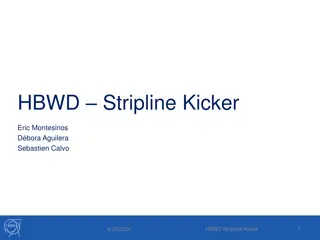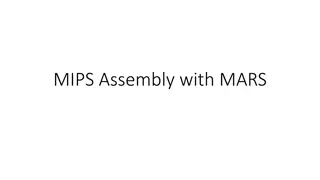
Introduction to MIPS Instruction Set Architecture in Assembly Language Programming
Explore the MIPS Instruction Set Architecture and its significance in Assembly Language Programming. Learn about data types, addressing modes, and exceptional conditions. Dive into the world of MIPS processors and their unique features.
Download Presentation

Please find below an Image/Link to download the presentation.
The content on the website is provided AS IS for your information and personal use only. It may not be sold, licensed, or shared on other websites without obtaining consent from the author. If you encounter any issues during the download, it is possible that the publisher has removed the file from their server.
You are allowed to download the files provided on this website for personal or commercial use, subject to the condition that they are used lawfully. All files are the property of their respective owners.
The content on the website is provided AS IS for your information and personal use only. It may not be sold, licensed, or shared on other websites without obtaining consent from the author.
E N D
Presentation Transcript
Introduction to Assembly Language Programming COE 301 Computer Organization Prof. Aiman El-Maleh College of Computer Sciences and Engineering King Fahd University of Petroleum and Minerals [Adapted from slides of Dr. M. Mudawar, COE 301, KFUPM]
Outline The MIPS Instruction Set Architecture Introduction to Assembly Language Defining Data Memory Alignment and Byte Ordering System Calls Introduction to Assembly Language Programming COE 301 KFUPM slide 2
Instruction Set Architecture (ISA) Critical interface between hardware and software An ISA includes the following Instructions and Instruction Formats Data Types, Encodings, and Representations Addressing Modes: to address Instructions and Data Handling Exceptional Conditions (like division by zero) Programmable Storage: Registers and Memory Examples (Versions) First Introduced in Intel (8086, 80386, Pentium, ...) 1978 MIPS (MIPS I, II, III, IV, V) 1986 PowerPC 1993 (601, 604, ) Introduction to Assembly Language Programming COE 301 KFUPM slide 3
Instructions Instructions are the language of the machine We will study the MIPS instruction set architecture Known as Reduced Instruction Set Computer (RISC) Elegant and relatively simple design Similar to RISC architectures developed in mid-1980 s and 90 s Very popular, used in many products Silicon Graphics, ATI, Cisco, Sony, etc. Comes next in sales after Intel IA-32 processors Almost 100 million MIPS processors sold in 2002 (and increasing) Alternative design: Intel IA-32 Known as Complex Instruction Set Computer (CISC) Introduction to Assembly Language Programming COE 301 KFUPM slide 4
Overview of the MIPS Processor . . . Memory 4 bytes per word Up to 232 bytes = 230 words . . . EIU FPU Execution & Integer Unit (Main proc) Floating Point Unit (Coproc 1) $0 $1 $2 F0 F1 F2 32 General Purpose Registers 32 Floating-Point Registers $31 F31 Arithmetic & Logic Unit Integer mul/div FP Arith ALU Floating-Point Arithmetic Unit Hi Lo TMU Trap & Memory Unit (Coproc 0) BadVaddr Status Cause Integer EPC Multiplier/Divider Introduction to Assembly Language Programming COE 301 KFUPM slide 5
MIPS General-Purpose Registers 32 General Purpose Registers (GPRs) Assembler uses the dollar notation to name registers $0 is register 0, $1 is register 1, , and $31 is register 31 All registers are 32-bit wide in MIPS32 $0 = $zero $1 = $at $2 = $v0 $3 = $v1 $4 = $a0 $5 = $a1 $6 = $a2 $7 = $a3 $8 = $t0 $9 = $t1 $10 = $t2 $11 = $t3 $12 = $t4 $13 = $t5 $14 = $t6 $15 = $t7 $16 = $s0 $17 = $s1 $18 = $s2 $19 = $s3 $20 = $s4 $21 = $s5 $22 = $s6 $23 = $s7 $24 = $t8 $25 = $t9 $26 = $k0 $27 = $k1 $28 = $gp $29 = $sp $30 = $fp $31 = $ra Register $0 is always zero Any value written to $0 is discarded Software conventions Software defines names to all registers To standardize their use in programs Example: $8 - $15 are called $t0 - $t7 Used for temporary values Introduction to Assembly Language Programming COE 301 KFUPM slide 6
MIPS Register Conventions Assembler can refer to registers by name or by number It is easier for you to remember registers by name Assembler converts register name to its corresponding number Name $zero $at $v0 $v1 $a0 $a3 $t0 $t7 $s0 $s7 $t8 $t9 $k0 $k1 $gp $sp $fp $ra Register $0 $1 $2 $3 $4 $7 $8 $15 $16 $23 $24 $25 $26 $27 $28 $29 $30 $31 Usage Always 0 Reserved for assembler use Result values of a function Arguments of a function Temporary Values Saved registers More temporaries Reserved for OS kernel Global pointer Stack pointer Frame pointer Return address (forced by hardware) (preserved across call) (points to global data) (points to top of stack) (points to stack frame) (used by jal for function call) Introduction to Assembly Language Programming COE 301 KFUPM slide 7
Instruction Formats All instructions are 32-bit wide. Three instruction formats: Register (R-Type) Register-to-register instructions Op: operation code specifies the format of the instruction Op6 Rs5 Rt5 Rd5 sa5 funct6 Immediate (I-Type) 16-bit immediate constant is part in the instruction Op6 Rs5 Rt5 immediate16 Jump (J-Type) Used by jump instructions Op6 immediate26 Introduction to Assembly Language Programming COE 301 KFUPM slide 8
Next . . . The MIPS Instruction Set Architecture Introduction to Assembly Language Defining Data Memory Alignment and Byte Ordering System Calls Introduction to Assembly Language Programming COE 301 KFUPM slide 9
Assembly Language Statements Three types of statements in assembly language Typically, one statement should appear on a line 1. Executable Instructions Generate machine code for the processor to execute at runtime Instructions tell the processor what to do 2. Pseudo-Instructions and Macros Translated by the assembler into real instructions Simplify the programmer task 3. Assembler Directives Provide information to the assembler while translating a program Used to define segments, allocate memory variables, etc. Non-executable: directives are not part of the instruction set Introduction to Assembly Language Programming COE 301 KFUPM slide 10
Instructions Assembly language instructions have the format: [label:] mnemonic [operands] [#comment] Label: (optional) Marks the address of a memory location, must have a colon Typically appear in data and text segments Mnemonic Identifies the operation (e.g. add, sub, etc.) Operands Specify the data required by the operation Operands can be registers, memory variables, or constants Most instructions have three operands L1: addiu $t0, $t0, 1 #increment $t0 Introduction to Assembly Language Programming COE 301 KFUPM slide 11
Comments Comments are very important! Explain the program's purpose When it was written, revised, and by whom Explain data used in the program, input, and output Explain instruction sequences and algorithms used Comments are also required at the beginning of every procedure Indicate input parameters and results of a procedure Describe what the procedure does Single-line comment Begins with a hash symbol # and terminates at end of line Introduction to Assembly Language Programming COE 301 KFUPM slide 12
Program Template # Title: # Author: # Description: # Input: # Output: ################# Data segment ##################### .data . . . ################# Code segment ##################### .text .globl main main: . . . li $v0, 10 syscall Filename: Date: # main program entry # Exit program Introduction to Assembly Language Programming COE 301 KFUPM slide 13
.DATA, .TEXT, & .GLOBL Directives .DATA directive Defines the data segment of a program containing data The program's variables should be defined under this directive Assembler will allocate and initialize the storage of variables .TEXT directive Defines the code segment of a program containing instructions .GLOBL directive Declares a symbol as global Global symbols can be referenced from other files We use this directive to declare main procedure of a program Introduction to Assembly Language Programming COE 301 KFUPM slide 14
Layout of a Program in Memory 0x7FFFFFFF Stack Grows Downwards Stack Segment Memory Addresses in Hex Dynamic Area Data Segment Static Area 0x10000000 Text Segment 0x04000000 Reserved 0 Introduction to Assembly Language Programming COE 301 KFUPM slide 15
Next . . . The MIPS Instruction Set Architecture Introduction to Assembly Language Defining Data Memory Alignment and Byte Ordering System Calls Introduction to Assembly Language Programming COE 301 KFUPM slide 16
Data Definition Statement Sets aside storage in memory for a variable May optionally assign a name (label) to the data Syntax: [name:] directive initializer [, initializer] . . . var1: .WORD 10 All initializers become binary data in memory Introduction to Assembly Language Programming COE 301 KFUPM slide 17
Data Directives .BYTE Directive Stores the list of values as 8-bit bytes .HALF Directive Stores the list as 16-bit values aligned on half-word boundary .WORD Directive Stores the list as 32-bit values aligned on a word boundary .WORDw:n Directive Stores the 32-bit value w into n consecutive words aligned on a word boundary. Introduction to Assembly Language Programming COE 301 KFUPM slide 18
Data Directives .HALF w:n Directive Stores the 16-bit value w into n consecutive half-words aligned on a half-word boundary . .BYTE w:n Directive Stores the 8-bit value w into n consecutive bytes. .FLOAT Directive Stores the listed values as single-precision floating point .DOUBLE Directive Stores the listed values as double-precision floating point Introduction to Assembly Language Programming COE 301 KFUPM slide 19
String Directives .ASCII Directive Allocates a sequence of bytes for an ASCII string .ASCIIZ Directive Same as .ASCII directive, but adds a NULL char at end of string Strings are null-terminated, as in the C programming language .SPACEn Directive Allocates space of n uninitialized bytes in the data segment Special characters in strings follow C convention Newline: \n Tab:\t Quote: \ Introduction to Assembly Language Programming COE 301 KFUPM slide 20
Examples of Data Definitions .DATA var1: .BYTE 'A', 'E', 127, -1, '\n' var2: .HALF -10, 0xffff var3: .WORD 0x12345678 Var4: .WORD 0:10 var5: .FLOAT 12.3, -0.1 var6: .DOUBLE 1.5e-10 str1: .ASCII "A String\n" str2: .ASCIIZ "NULL Terminated String" array: .SPACE 100 Introduction to Assembly Language Programming COE 301 KFUPM slide 21
Next . . . The MIPS Instruction Set Architecture Introduction to Assembly Language Defining Data Memory Alignment and Byte Ordering System Calls Introduction to Assembly Language Programming COE 301 KFUPM slide 22
Memory Alignment Memory is viewed as an array of bytes with addresses Byte Addressing: address points to a byte in memory Words occupy 4 consecutive bytes in memory Memory MIPS instructions and integers occupy 4 bytes address . . . Alignment: address is a multiple of size aligned word Word address should be a multiple of 4 not aligned 12 8 Least significant 2 bits of address should be 00 4 not aligned 0 Halfword address should be a multiple of 2 .ALIGN ndirective Aligns the next data definition on a 2n byte boundary Introduction to Assembly Language Programming COE 301 KFUPM slide 23
Memory Alignment .align 0 turns off automatic alignment of .half, .word, .float, and .double directives until the next .data or .kdata directive. Example: If the address of X is 0x10010000, then Address of Y is 0x10010002 .align 0 X: .byte 1,2 Y: .word 10 Alignment has to satisfy both the automatic boundary and the boundary given in the align directive Example: If the address of X is 0x10010000, then Address of Y is 0x10010004 x: .byte 1 .align 1 y: .word 1 Introduction to Assembly Language Programming COE 301 KFUPM slide 24
Symbol Table Assembler builds a symbol table for labels (variables) Assembler computes the address of each label in data segment Example Symbol Table .DATA var1: .BYTE 1, 2,'Z' str1: .ASCIIZ "My String\n" var2: .WORD 0x12345678 .ALIGN 3 var3: .HALF 1000 Label Address var1 str1 var2 var3 0x10010000 0x10010003 0x10010010 0x10010018 str1 var1 1 0x12345678 2 'Z' 'M' 'y' ' ' 'S' 't' 'r' 'i' 'n' 'g' '\n' 0 1000 0 0 0 0 Unused 0 0 0x10010000 0x10010010 var2 (aligned) Unused 0 0 0 0 0 0 var3 (address is multiple of 8) Introduction to Assembly Language Programming COE 301 KFUPM slide 25
Byte Ordering and Endianness Processors can order bytes within a word in two ways Little Endian Byte Ordering Memory address = Address of least significant byte Example: Intel IA-32, Alpha a a+1 a+2 a+3 MSB LSB address . . . . . . Byte 3 Byte 2 32-bit Register Byte 1 Byte 0 Byte 0 Byte 1 Byte 2 Byte 3 Memory Big Endian Byte Ordering Memory address = Address of most significant byte Example: SPARC, PA-RISC a a+1 a+2 a+3 MSB LSB address . . . . . . Byte 3 Byte 2 32-bit Register Byte 1 Byte 0 Byte 3 Byte 2 Byte 1 Byte 0 Memory MIPS can operate with both byte orderings Introduction to Assembly Language Programming COE 301 KFUPM slide 26
Next . . . The MIPS Instruction Set Architecture Introduction to Assembly Language Defining Data Memory Alignment and Byte Ordering System Calls Introduction to Assembly Language Programming COE 301 KFUPM slide 27
System Calls Programs do input/output through system calls MIPS provides a special syscall instruction To obtain services from the operating system Many services are provided in the SPIM and MARS simulators Using the syscall system services Load the service number in register $v0 Load argument values, if any, in registers $a0, $a1, etc. Issue the syscall instruction Retrieve return values, if any, from result registers Introduction to Assembly Language Programming COE 301 KFUPM slide 28
Syscall Services Service Print Integer Print Float Print Double Print String Read Integer Read Float Read Double $v0 Arguments / Result 1 $a0 = integer value to print 2 $f12 = float value to print 3 $f12 = double value to print 4 $a0 = address of null-terminated string 5 Return integer value in $v0 6 Return float value in $f0 7 Return double value in $f0 $a0 = address of input buffer $a1 = maximum number of characters to read $a0 = number of bytes to allocate Return address of allocated memory in $v0 10 Read String 8 Allocate Heap memory Exit Program 9 Introduction to Assembly Language Programming COE 301 KFUPM slide 29
Syscall Services Contd Print Char Read Char 11 12 $a0 = character to print Return character read in $v0 $a0 = address of null-terminated filename string $a1 = flags (0=read, 1=write, 9=append) $a2 = mode (ignored) Return file descriptor in $v0 (negative if error) $a0 = File descriptor $a1 = address of input buffer $a2 = maximum number of characters to read Return number of characters read in $v0 $a0 = File descriptor $a1 = address of buffer $a2 = number of characters to write Return number of characters written in $v0 $a0 = File descriptor Open File 13 Read from File 14 Write to File 15 Close File 16 Introduction to Assembly Language Programming COE 301 KFUPM slide 30
Reading and Printing an Integer ################# Code segment ##################### .text .globl main main: li $v0, 5 syscall # main program entry # Read integer # $v0 = value read move $a0, $v0 li $v0, 1 syscall # $a0 = value to print # Print integer li syscall $v0, 10 # Exit program Introduction to Assembly Language Programming COE 301 KFUPM slide 31
Reading and Printing a String ################# Data segment ##################### .data str: .space 10 # array of 10 bytes ################# Code segment ##################### .text .globl main main: # main program entry la $a0, str # $a0 = address of str li $a1, 10 # $a1 = max string length li $v0, 8 # read string syscall li $v0, 4 # Print string str syscall li $v0, 10 # Exit program syscall Introduction to Assembly Language Programming COE 301 KFUPM slide 32
Program 1: Sum of Three Integers # Sum of three integers # # Objective: Computes the sum of three integers. # Input: Requests three numbers. # Output: Outputs the sum. ################### Data segment ################### .data prompt: .asciiz "Please enter three numbers: \n" sum_msg: .asciiz "The sum is: " ################### Code segment ################### .text .globl main main: la $a0,prompt li $v0,4 syscall li $v0,5 syscall move $t0,$v0 # display prompt string # read 1st integer into $t0 Introduction to Assembly Language Programming COE 301 KFUPM slide 33
Sum of Three Integers Slide 2 of 2 li $v0,5 syscall move $t1,$v0 # read 2nd integer into $t1 li $v0,5 syscall move $t2,$v0 # read 3rd integer into $t2 addu $t0,$t0,$t1 addu $t0,$t0,$t2 # accumulate the sum la $a0,sum_msg li $v0,4 syscall # write sum message move $a0,$t0 li $v0,1 syscall # output sum li $v0,10 syscall # exit Introduction to Assembly Language Programming COE 301 KFUPM slide 34
Program 2: Case Conversion # Objective: Convert lowercase letters to uppercase # Input: Requests a character string from the user. # Output: Prints the input string in uppercase. ################### Data segment ##################### .data name_prompt: .asciiz out_msg: .asciiz in_name: .space 31 ################### Code segment ##################### .text .globl main main: la $a0,name_prompt # print prompt string li $v0,4 syscall la $a0,in_name li $a1,31 li $v0,8 syscall "Please type your name: " "Your name in capitals is: " # space for input string # read the input string # at most 30 chars + 1 null char Introduction to Assembly Language Programming COE 301 KFUPM slide 35
Case Conversion Slide 2 of 2 la $a0,out_msg # write output message li $v0,4 syscall la $t0,in_name loop: lb $t1,($t0) beqz $t1,exit_loop # if NULL, we are done blt $t1,'a',no_change bgt $t1,'z',no_change addiu $t1,$t1,-32 # convert to uppercase: 'A'-'a'=-32 sb $t1,($t0) no_change: addiu $t0,$t0,1 # increment pointer j loop exit_loop: la $a0,in_name # output converted string li $v0,4 syscall li $v0,10 # exit syscall Introduction to Assembly Language Programming COE 301 KFUPM slide 36

